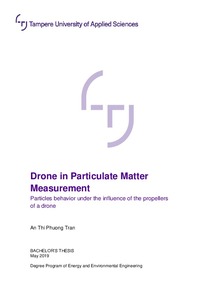Drone in Particulate Matter Measurement
Tran, An Thi Phuong (2019)
Tran, An Thi Phuong
2019
All rights reserved. This publication is copyrighted. You may download, display and print it for Your own personal use. Commercial use is prohibited.
Julkaisun pysyvä osoite on
https://urn.fi/URN:NBN:fi:amk-2019061917351
https://urn.fi/URN:NBN:fi:amk-2019061917351
Tiivistelmä
Particulate matter is fine solid particle or liquid droplets found in the air that is not visible to the bare eye. It is widely known to have a serious effect on both human health and the environment. Thus, air quality monitoring is necessary for studying and understanding of particles sources, behavior and concentration in order to minimise the impacts. Recently, Unmanned Aerial Vehicles (UAVs) has risen as a new method that is believed to overcome a variety of limitations that current methods hold Among other things, it makes it easy to access any complex area, is convenient in collecting data of vertical atmosphere, is simple to handle and is available at low-cost. However, there are still some issues in using UAV in aerosols measurement that need to be experimented and studied further.
The aim of the research is experiment and analysis on performance, practicality as well as obstacles of applying a drone in measuring air quality and concentration of fine dust specifically in impact of propellers on PM concentration results. In addition, the study also focuses on distribution of air-borne particles at different altitudes and behaviour of different size particles under impacts of wind. The experiment was done using 2 particulate meters: Trotec PC220 and DustTrak under impact of flying drone Phantom 4 PRO. Trotec is hung above drone while DustTrak is placed 2.3 m away to study the propeller’s impacts at different distance. The results are collected in indoor environment and it shows significant impacts of propellers on PM concentration in surrounding environment even when the sensor is placed 2.3 m away. The wind speed is lower and lower as it goes further away above the drone and PM concentration also decrease proportionally. However, further study in different environments such as outdoor, industrial site with more constant ambient concentration is needed for deeper understand on mechanism of the impact of the propeller.
The aim of the research is experiment and analysis on performance, practicality as well as obstacles of applying a drone in measuring air quality and concentration of fine dust specifically in impact of propellers on PM concentration results. In addition, the study also focuses on distribution of air-borne particles at different altitudes and behaviour of different size particles under impacts of wind. The experiment was done using 2 particulate meters: Trotec PC220 and DustTrak under impact of flying drone Phantom 4 PRO. Trotec is hung above drone while DustTrak is placed 2.3 m away to study the propeller’s impacts at different distance. The results are collected in indoor environment and it shows significant impacts of propellers on PM concentration in surrounding environment even when the sensor is placed 2.3 m away. The wind speed is lower and lower as it goes further away above the drone and PM concentration also decrease proportionally. However, further study in different environments such as outdoor, industrial site with more constant ambient concentration is needed for deeper understand on mechanism of the impact of the propeller.
